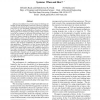Free Online Productivity Tools
i2Speak
i2Symbol
i2OCR
iTex2Img
iWeb2Print
iWeb2Shot
i2Type
iPdf2Split
iPdf2Merge
i2Bopomofo
i2Arabic
i2Style
i2Image
i2PDF
iLatex2Rtf
Sci2ools
IPPS
1996
IEEE
1996
IEEE
Benefits of Processor Clustering in Designing Large Parallel Systems: When and How?
Advances in multiprocessor interconnect technologyare leading to high performance networks. However, software overheadsassociated with message passing are limiting the processors to get maximum performance from these networks, leading to under-utilization of network resources. Though processor-clusters are being used in some systems in an ad hoc manner to alleviate this problem, there is no formal analysis in the literature to show when and how processor clusters benefit in designing high performance and scalable systems. In this paper we analyze and solve this problem by considering processor-clustering, messaging overheads, and network performance in an integrated manner. Our analysis establishes the following three design guidelines. Compared to a base system, under high messaging overheads, processor clustering can be used to build a) an equal-sized system with a smaller network or b) a larger system with an equal-sized network. Under low messaging overheads, a combination of proc...
Distributed And Parallel Computing | IPPS 1996 | Messaging Overheads | Multiprocessor Interconnect Technologyare | Processor Clustering |
Related Content
| Added | 07 Aug 2010 |
| Updated | 07 Aug 2010 |
| Type | Conference |
| Year | 1996 |
| Where | IPPS |
| Authors | Debashis Basak, Dhabaleswar K. Panda, Mohammad Banikazemi |
Comments (0)

